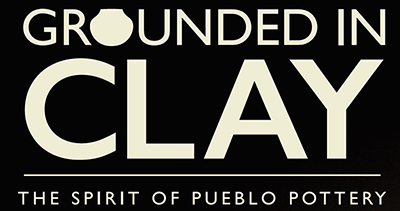Russell Sanchez
San Ildefonso Pueblo
Curator Russell Sanchez (San Ildefonso) is a potter and tribal leader. He is a traditionalist at heart and believes that part of “tradition” is moving forward and not being stuck in the past.
Russell chose the following for the Grounded in Clay exhibit:
San Ildefonso Water Jar
This pot probably sat in a corner of a room, in a space convenient enough for it to be used for dipping a drink of water or for preparing meals. Smaller jars were used to bring in water from the wells or river, and the water was then poured into a larger jar. There is a stain around the rim of the pot from the oils of people’s hands, also slight discoloration, scratches on the surface, and the earthen smell of water. The pot is carefully engineered and significantly worn in ways typical of a water jar. Its narrow opening prevents spillage when a dipper is used to retrieve water, and the concave base allows the summer heat to dissipate, cooling the jar and its contents.
This is an exquisite jar, carefully and lovingly formed and painted. Clays, slips, and paints are all harvested locally. Here, the slip is stone-polished, and the jar has been used for storing and serving water. The evenness of the designs indicates that a skilled potter painted the jar. Some might mistake the double wavy lines as depicting the water serpent Avanyu or another ceremonial symbol, but they simply depict water and hills. Above and below the wavy lines are rain clouds. Inside the jar’s rim is another set of rain clouds, this set with green plant life emerging. The terraced symmetrical design filled with hatched lines indicates rainfall. This is a design of our village and not something borrowed from another Pueblo.
Although we cannot assume one person used one design exclusively, the “steps” are a unique identifier, and because rapacious ownership runs counter to the communal nature of pottery-making, jars like this are often labeled erroneously as kiva pots.¹ I find the idea offensive. It undercuts community and suggests that potters do not have the ingenuity to be continually trying new designs. These types of label do not take into account the deep meanings and knowledge that reside within our community.
Outsiders who create these labels do not fully understand the Tewa world. Even the most knowledgeable curator cannot spend a lifetime immersed in and participating at P’o Woe-geh Owingeh. If they did, they would comprehend that the use of a stepped rim is not an automatic indicator of a ceremonial jar. It is the actual use of the jar and the proper prayers in appropriate contexts that create a jar that might be labeled “ceremonial.” Such jars are not seen in public and do not leave our village; they are in constant use. When no longer able to serve their purpose, they are put to rest, just like any other community member.
Non-Native labels give pots like these a higher monetary value because the collector has seemingly collected the forbidden. Labels given by non–San Ildefonso people to our pottery often make no sense. While there is a stepped cut along the rim and this same stepped motif is publicly visible on buildings called kivas, these designs are not exclusive to one type of building or to one type of jar. Plain and simple, the stepped design represents the mountains.
¹ This pot was identified erroneously as a “ceremonial kiva pot” by an unknown person before this project began.

